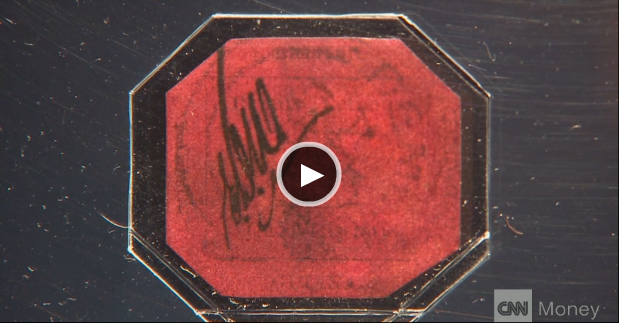money.cnn.com | By Jillian Eugenios | June 18, 2014

Watch Video
NEW YORK (CNNMoney)
It’s been called the most valuable item in the world by weight. The British Guiana One-Cent Magenta just became the most expensive stamp ever sold.
The stamp, weighing just 0.04 grams, was auctioned by Sotheby’s Tuesday, bringing in $9.48 million, just shy of the price range expected by Sotheby’s experts, but still enough to break the world record. Until then, the most expensive stamp ever sold was the Treskilling Yellow, which broke records when it sold for $2.2 million in 1996.
The stamp is famous in collector’s circles, and while the winning bidder has chosen to remain anonymous, David Redden, the vice chairman of Sotheby’s, told CNNMoney before the auction that he suspected the top bidder would be someone who had been a stamp collector from a young age, just like he was.
“I could well imagine someone who collected stamps as a child, always knew about this particular stamp, has now created some real wealth for themselves, and they think, ‘My goodness. I can actually pay tribute to that little child who I was once upon a time and buy the greatest stamp in the world,'” he said.
After the auction, Redden kept mum about details of the buyer, saying only that the buyer was a “collector,” not an investor.
Redden said the auction house was pleased with the outcome. “This is the most valuable item in the world by weight,” he said. “It’s just a tiny piece of paper.”
The history of this stamp is famous among collectors:
In 1856, a postmaster in British Guiana (now Guyana, on the northern coast of South America), ran out of stamps, and the shipment of a new batch was late. He asked a local newspaper to print an emergency issue of several stamps to hold him over. Among them was the British Guiana One-Cent Magenta, and only one of its kind is still known to exist today.
The stamp was first discovered by a 12-year-old boy in 1873, 17 years after it was printed. The boy, a stamp collector himself, couldn’t find a reference to the stamp in his catalog and sold it for six shillings — about $50 today.
After that, the stamp passed through several owners for nearly the next century, until it was bought by American millionaire (and convicted murderer) John E. du Pont, who snapped it up for $935,000 in 1980. He died in prison in 2010, and his estate brought the stamp to auction.
According to Redden, stamp collecting is a sort of gateway drug to collecting other items of value, like fine art or antiques.
“So many collectors, whether they collect paintings or works of art, began life as stamp collectors,” he said.
Passionate stamp enthusiasts are still active, both online and off, but organized stamp collecting seems to have waned in the past couple decades.
“Our membership has fallen over the past 15, 20 years … it’s pretty close to flat right now,” said Ken Martin, the executive director of The American Philatelic Society. The organization works to recruit new members through social activities and educational outreach.
Stamp collecting remains a potentially worthwhile financial investment. Researchers who studied stamp appreciation of British stamps from 1900-2008 found that “returns are higher than those on bonds but below those on equities.”
The researchers, Elroy Dimson and Christopher Spaenjers, said that the risk of stamp collecting is relatively low, and said they found that the annualized return on stamps was similar to returns on art investments, coming in at 7% in nominal terms, or 2.9% in real terms.
After the auction Tuesday, Sotheby’s David Redden held the stamp, clutching its glass encasement with his white-gloved hands. For him, the sale was bittersweet. “I have to say I’m a little sad to see it go,” he said. ” When I was eight years old this was the most precious object in the entire world, and I never dreamed I would have it in my hands.”



